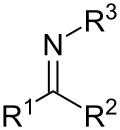A cofactor is a non-protein chemical compound or metallic ion that is required for an enzyme's role as a catalyst (a catalyst is a substance that increases...
48 KB (4,931 words) - 19:57, 4 October 2024
Look up cofactor in Wiktionary, the free dictionary. Cofactor may also refer to: Cofactor (biochemistry), a substance that needs to be present in addition...
693 bytes (129 words) - 08:04, 29 May 2023
Biotin (category Cofactors)
Propionyl-CoA carboxylase (PCC) For the first two, biotin serves as a cofactor responsible for transfer of bicarbonate to acetyl-CoA, converting it to...
48 KB (5,181 words) - 04:28, 2 November 2024
Enzyme (redirect from Cofactors and coenzymes)
carboxylase). An example of an enzyme that contains a cofactor is carbonic anhydrase, which uses a zinc cofactor bound as part of its active site. These tightly...
96 KB (9,821 words) - 16:54, 27 October 2024
Biochemistry or biological chemistry is the study of chemical processes within and relating to living organisms. A sub-discipline of both chemistry and...
59 KB (6,458 words) - 05:52, 27 September 2024
Pyrroloquinoline quinone (redirect from Pqq cofactor)
PMID 27230956. Felton LM, Anthony C (2005). "Biochemistry: role of PQQ as a mammalian enzyme cofactor?". Nature. 433 (7025): E10, discussion E11–2. Bibcode:2005Natur...
11 KB (1,056 words) - 10:00, 2 May 2024
from conformational change and loss of solubility or dissociation of cofactors to aggregation due to the exposure of hydrophobic groups. The loss of...
30 KB (3,182 words) - 02:16, 27 October 2024
FeMoco (redirect from FeMo cofactor)
FeMoco (FeMo cofactor) is the primary cofactor of nitrogenase. Nitrogenase is the enzyme that catalyzes the conversion of atmospheric nitrogen molecules...
13 KB (1,568 words) - 00:53, 21 October 2024
Fermentation (redirect from Fermentation (biochemistry))
electrons are released and accepted by redox cofactors (NAD and ferredoxin). At later points, these cofactors donate electrons to their final acceptor and...
42 KB (4,807 words) - 06:34, 28 October 2024
Nicotinamide adenine dinucleotide (redirect from Nicotinamide cofactor)
"From Genetic Footprinting to Antimicrobial Drug Targets: Examples in Cofactor Biosynthetic Pathways". J. Bacteriol. 184 (16): 4555–4572. doi:10.1128/JB...
79 KB (9,020 words) - 21:04, 28 October 2024
SidA is a highly specific ornithine hydroxylase with bound flavin cofactor". Biochemistry. 49 (31): 6777–6783. doi:10.1021/bi100291n. PMID 20614882. Zdobnov...
13 KB (1,005 words) - 16:01, 30 March 2024
Biosynthesis (redirect from Production rate (biochemistry))
examples is: Precursor molecule + Cofactor → e n z y m e macromolecule {\displaystyle {\ce {{Precursor~molecule}+Cofactor->[][enzyme]macromolecule}}} Simple...
61 KB (6,770 words) - 15:11, 20 August 2024
citric acid - citric acid cycle - cladistics - cloning - coenzyme - cofactor (biochemistry) - colchicine - collagen - colloid - colony-stimulating factor -...
29 KB (2,471 words) - 04:50, 19 January 2024
dihydrolipoamide acetyltransferase (E2), dihydrolipoamide dehydrogenase (E3), six cofactors: thiamine pyrophosphate (TPP), lipoamide, coenzyme A (CoA), flavin adenine...
12 KB (1,563 words) - 10:53, 6 August 2024
Schiff base (section Biochemistry)
reversibly reacts with an aldehyde or ketone of a cofactor or substrate. The common enzyme cofactor pyridoxal phosphate (PLP) forms a Schiff base with...
9 KB (880 words) - 17:14, 22 September 2024
Tetrahydrobiopterin (BH4, THB), also known as sapropterin (INN), is a cofactor of the three aromatic amino acid hydroxylase enzymes, used in the degradation...
32 KB (2,818 words) - 22:34, 18 October 2024
Nicotinamide (section Biochemistry)
tons of nicotinamide were sold in 2014. Nicotinamide, as a part of the cofactor nicotinamide adenine dinucleotide (NADH / NAD+) is crucial to life. In...
28 KB (2,425 words) - 17:10, 23 October 2024
biochemistry can be said to have started with the ancient Greeks who were interested in the composition and processes of life, although biochemistry as...
25 KB (3,034 words) - 15:40, 2 January 2024
Flavin adenine dinucleotide (category Cofactors)
proteins, however, generate and maintain a superoxidized form of the flavin cofactor, the flavin-N(5)-oxide. Flavoproteins were first discovered in 1879 by...
39 KB (4,310 words) - 14:35, 24 September 2024
incorporated into important cofactors of enzymatic reactions (e.g., coenzyme A, FAD, FMN, NAD, and NADP+). In experimental biochemistry, nucleotides can be radiolabeled...
32 KB (3,305 words) - 17:40, 3 September 2024
Flavin mononucleotide (category Cofactors)
of various oxidoreductases, including NADH dehydrogenase, as well as a cofactor in biological blue-light photo receptors. During the catalytic cycle, a...
7 KB (489 words) - 10:17, 18 September 2024
activity. Others require non-protein molecules called cofactors to be bound for activity. Cofactors can be either inorganic (e.g., metal ions and iron-sulfur...
4 KB (405 words) - 04:35, 26 September 2024
inhibitory effects on enzymes, catalytic activity of their own (usually as a cofactor to an enzyme), defense, and interactions with other organisms (e.g. pigments...
4 KB (402 words) - 20:58, 5 May 2024
Pterin (category Cofactors)
D, Voet JG (2004). Biochemistry (3rd ed.). John Wiley & Sons. ISBN 0-471-39223-5. Schwarz G, Mendel RR (2006). "Molybdenum cofactor biosynthesis and molybdenum...
12 KB (1,076 words) - 16:10, 23 September 2024
Prosthetic group (category Cofactors)
property. Prosthetic groups are a subset of cofactors. Loosely bound metal ions and coenzymes are still cofactors, but are generally not called prosthetic...
8 KB (817 words) - 23:04, 18 October 2024
F430 is the cofactor (sometimes called the coenzyme) of the enzyme methyl coenzyme M reductase (MCR). MCR catalyzes the reaction EC 2.8.4.1 that releases...
10 KB (903 words) - 19:19, 23 September 2023
Protein (redirect from Protein (biochemistry))
non-peptide groups attached, which can be called prosthetic groups or cofactors. Proteins can also work together to achieve a particular function, and...
103 KB (11,472 words) - 16:37, 31 October 2024
Flux (metabolism) (redirect from Flux (biochemistry))
In biochemistry, metabolic flux (often referred to as flux) is the rate of turnover of molecules through a metabolic pathway. Flux is regulated by the...
10 KB (1,305 words) - 17:32, 13 October 2024
Metabolism (section Mineral and cofactors)
being most abundant of those. Metal cofactors are bound tightly to specific sites in proteins; although enzyme cofactors can be modified during catalysis...
113 KB (12,407 words) - 11:21, 2 November 2024




















